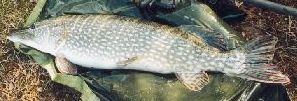The pike is a long and slender fish with dorsal and anal fins positioned well towards the tail. Overall colour is green with small, irregularly shaped pale yellow spots lending it efficient camouflage in an aquatic environment. Colour can vary somewhat from water to water, as can the shapes and sizes of the spot markings – no doubt in response to its surroundings. Juvenile pike (often referred to by anglers as ‘jacks’ or ‘jack pike’) exhibit vertical bars. The snout of a pike is pointed and the eyes are forward looking giving the pike binocular vision. Its most noticeable features, which sets it apart from all other freshwater fish in Britain, are its teeth. Pike teeth are pointed with razor sharp edges. As you might have guessed by now, the pike is a predatory fish! Pike can grow to over four feet in length and weights in excess of forty pounds, but three feet is a good size which might represent a weight of around thirteen pounds.

Preferred Habitat
Pike inhabit almost every type of freshwater found in Britain, both still and flowing, large and small, and they exist as far south as Devon and northwards to the highlands of Scotland. Globally, pike are found throughout the northern hemisphere – in northern Europe and North America.
Preferred Baits
As adult pike have a diet consisting almost entirely of fish (but know to include occasional aquatic mammals and birds) the preferred baits are live or dead fish, and artificial lures.
Tackle Required
Because pike have sharp teeth that can cut through line, a wire trace of at least 20lbs test is required at all times when fishing specifically for pike. Line strength should not be less than 12lbs as pike are not normally tackle shy, and can fight hard and grow large. You can never guess how big, or small, your next pike is going to be – small pike are greedy fish and will take large baits and lures intended for big pike! Strong tackle will not deter the little pike. The rod used for pike fishing will have to cast heavy baits at times, as well as a weight to hold the bait in place. The combined weight of bait and rig being cast might be around half a pound, so a sufficiently sturdy rod will be needed. One with a test curve between 2.5 and 3.5lbs is a safe bet for effective pike fishing.
Record & Specimen Weights
The currently accepted British Record pike weighed 46lb 13oz and was caught from Llandegfedd Reservoir in Wales by Roy Lewis in 1992. The world record is believed to be a 55lbs 1oz fish caught in Germany by Lothar Louis in 1986. Although hardened pikers search out twenty pounders and bigger, a pike over ten pounds in weight can be considered a specimen from most waters.
Organisations For Further Information
The Pike Anglers’ Club of Great Britain was formed in 1977 and has been working towards a situation where pike are a valued sporting fish and a necessary part of the management and ecology of freshwaters throughout Great Britain ever since. The PAC has regional associations throughout England, Scotland, Wales and Northern Ireland. More information on the PAC, its events and publications, and of course the pike and how to fish and care for it at www.pacgb.com
In Ireland pike anglers have the Irish Pike Society who can be found at www.irishpikesociety.com
The Pike Anglers Alliance for Scotland can be found at www.esoxecosse.co.uk
There are other pike angling and conservation groups around the world such as Pikemasters in the USA and SNB in Holland/Belgium to name just two.
–*–
If you are interested in cheap pike fishing tackle and bait, please click here.








